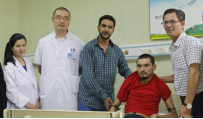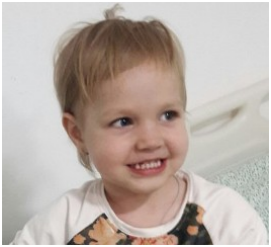May 2007 (Second Course of Treatment)
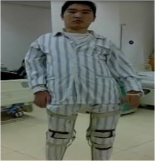
Mr. Dong is a Chinese 24 years old male patient suffering from spinal cord injury. He happened to be injured to his head, face, neck by falling walls in 2005. MRI of his spinal cord before the stem cell implantation showed: C3-C7 spinal cord disconnected and liquefied. He was given the first stem cell treatment and almost 1 year rehabilitation therapy.
This patient’s story is edited and produced into a short film, which is published on a TV programme, named "From Broken Neck to Recovery" of CCTV channel and can be watched globally.
Pre-Treatment Condition (Before the First Course of Treatment)
1. Motor function: Upper limbs showed muscle atrophy. Left upper limb could be slightly lifted but not high, with claw-like immobile fingers. Right upper limb couldn't be fully lifted, with limited movement on bed, unable to turn the wrist and fully move fingers (claw appearance). Lower limbs were paralyzed with no voluntary movement.
2. Sensation function: Sensation was lost beneath 3 cm above the nipple level. There was no perception of urination and bowel movement.
3. Muscular tension: High muscular tension in upper limbs with stiffness. Lower limbs were in bending and contracture status. Right lower limb could be stretched by external force but curled back soon, and left lower limb couldn't be stretched. Lower limb muscular tension increased, and they closed tightly and couldn't be separated with external stimulation.
4. Neural reflex: Bilateral abdominal reflex disappeared.
5. Sweating and urination/bowel movement: Only the area on the top of 3cm above the nipple level of the front chest could sweat, with the rest of the body losing sweating function and poor body temperature adjustment. No perception of bowel movement and urinary incontinence.
First Course of Stem Cell Treatment (Sep 2006)
Outcomes After the First Course of Treatment (16 days)
1.Motor function: Left upper limb can lift, wrists more flexible but can't move or bear load. Right upper limb shows muscle tendon contraction, wrists can turn over, but can't lift, move on bed or bear load.
2.Sensation function: Right side pain feeling level lowered to right costal arch, touching feeling level to navel level. Left side pain feeling level lowered to 2cm beneath left costal arch.
3.Muscular tension: Fingers and lower limbs' muscular tension improved significantly. Lower limbs can stretch straight with external help in stationary state.
4.Neural reflex: Left abdominal reflex elicited, right abdominal reflex not restored.
5.Sweating function: Sweating level lowered to the touching feeling level.
Outcomes After the First Course of Treatment (44 days)
1. Motor function: Left upper limb muscle volume increased, can be lifted higher (up to mouth level), wrists more flexible, able to lift 2kg dumbbell 40-50 times. Right upper limb shows muscle tendon contraction, right wrist turns over more flexibly.
2. Muscular tension: Fingers and lower limbs' muscular tension improved, lower limbs can be stretched straight with external help in stationary state.
3. Sensation function: Left pain feeling level lowered to 2cm beneath left costal arch, touching feeling level to anterior superior iliac spine level.
4. Sweating function: Sweating level lowered to the hip.
5. Neural reflex: Bilateral abdominal reflex can be elicited.
Second Course of Stem Cell Treatment (May 2007)
Treatment Methods:Stereotactic brain surgery + Lumber puncture + Interventional therapy
Outcomes After the Second Course of Treatment
1. Upper limb muscle strength improved. Right upper limb can lift and move. Left wrist can turn in and out (previously only inwards), left thumb can bend slightly.
2. Waist muscle strength improved. Can stand over 1 hour with family and brace, and can stand alone holding bedside with left hand (unable before).
3. Sensation level lowered to navel. Cold/hot sensation area moved from above clavicle to xiphoid level in front and to hip at back.
4. Sweating function restored normally.
5. Urination and bowel movement: Can perceive both, and sphincter contraction during bowel movement using abdominal muscles. Can control urination over 1 minute before release, with increased urine and bladder volume. Now urinates 3 times a day instead of anytime.
6. Upper limb and chest muscle volume increased, weight up by 5kg.
7. Partial restoration of penis erection.
Outcomes After the Third Course of Treatment ( Feb 2008)
1. Can stand stably alone for a long time.
2. Can sit alone at bedside and cross legs independently in bed for over 1 hour.
3. Lower limb muscular tension further improved, better flexibility of lower limbs when lying on back.
4. Obvious reduction in limb spasm.
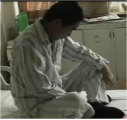
Outcomes After the Fourth Course of Treatment ( Jan 2009)
1. Waist and lower limb muscle strength significantly improved, can stand with brace for about 10 minutes.
2. Easier urination and bowel movement.
Outcomes After the Fifth Course of Treatment ( Mar 2010)
1. Upper limb muscle strength greatly improved, can pull a 5kg heavy object.
2. Marked increase in upper limb flexibility, can play and type on the computer.
3. Further reduction in whole body muscular tension, better lower limb flexibility when lying, can stand independently for a longer time.
4. Further reduction in limb spasm.
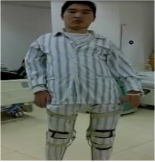
Progress Summary & Future Outlook
Before receiving stem cell treatment, Dong Chuan's physical functions were severely impaired.
After receiving stem cell treatment, his physical condition gradually improved. From 2008 to 2010, he continued to make progress in aspects such as standing ability, sitting posture, limb flexibility, and muscle strength. The spasm was further reduced, and urination and defecation became easier.
Judging from Dong Chuan's treatment journey, stem cell treatment has shown great potential. In the future, with the continuous development and improvement of stem cell technology, breakthroughs are expected to be more.
More detailed stories about Dong Chuan’s treatment (click here)
The Reborn of Broken Neck
Mr. Dong Chuan was accidentally injured in 2005. His head and neck were compressed into the chest. The comminuted fracture of the cervical spine directly cut off the nerve bundle in the spinal cord, which resulted to high paraplegia. After injury, Mr. Dong cannot feel anything below neck. He can‘t sweat and lost the thermoregulatory function. The body temperature often climbed to 41 C. His lung function was also affected, causing respiratory infections and incontinence. In this world, the most difficult thing is not how to cross the moment of the birth and death, but to live again after death. His body became completely strange. He wants to drink water, but he can’t lift his fingers. He wants to turn over, but his legs can‘t be picked up, and all the organs were no longer listening to him. In desperation, Mr. Dong ‘s parents learned that the General hospital of Chinese People’s Armed Police Forces had a magical treatment for the sequela of spinal cord injury-Stem cell transplantation. In July 2006, under the escort of military medical staff, Mr. Dong was sent to the Stem Cell Transplantation Department in Beijing.
On the day of admission, our experts led a medical group to conduct a detailed examination and analysis of Mr. Dong conditions, and repeatedly revised his treatment plan. Conventional stem cell transplantation is performed by lumbar puncture. However, experts found in the examination that Mr. Dong's cervical vertebrae 3-7 comminuted fracture, liquefaction and meningeal damage caused spinal canal adhesion and stenosis. So the protein content in cerebrospinal fluid had reached ten times compared with the normal value. This indicates that Mr. Dong's spinal canal was completely unobstructed, and it was difficult for the stem cells to move up and down in the spinal canal after transplantation. So as to achieve the purpose of active repairing damaged cells. expert decided to try a new intervention point. After repeated argumentation, with the assistance of the assistant, our experts cut directly from the damaged cervical vertebrae to relieve the obstructed spinal canal, which could loosen the severely attached nerve roots. After that, our experts injected 4 units of stem cells into the upper and lower ends of the damaged spinal cord. After the transplantation Mr. Dong's body changed a little bit. On the second day, his parents found Mr. Dong’s double fists could be smoothed open when massaged him. On the 16th day, Mr. Dong's wrist can be turned over, and the body above the navel can sweat On the 44th day, his left upper limb can lift 4kgs of dumbbells about 40 to 50 times for one time. His hip also could sweat normally. Mr. Dong’s parents were moved to tears and hugged together along with his body changing a little bit magically.
Our experts spent a lot of time studying Mr. Dong's treatment plan. Since Mr. Dong's cervical pith was implanted with a steel plate, in order to minimize the trauma of stem cell transplantation but with best improvements, our experts decided to design a minimally invasive transplantation technique for Mr. Dong. At the end of May 2007, Mr. Dong received the second course of stem cell transplantation. In this course, our experts decided to indirectly repair the injured nerve in the lower part by nutritionally repairing the upper nerve. This time, our experts decided to transplant the stem cells directly into the inner capsule of the brain tissue. During the operation, Mr. Dong's head was fixed with a semi-circular metal bracket. The CT imaging system slowly swept through the head of Dong Chuan, accurately calibrating the orientation of the brain tissue through stereotactic orientation, and guiding the accurate injection of stem cells. After an hour, the operation was successfully completed. After the operation, Mr. Dong's body appeared a miracle. His upper limbs gradually lifted 20kgs objects. The once-shrinking bladder gradually recovered its function, and the whole body sweating function completely returned to normal. One month later, it was enough to make people aware that Mr. Dong has been able to stand up independently under the protection of the brace! Mr. Dong became the first patient in China to stand up again.
"I used to be a warrior. Now I am a fighter. It is my greatest happiness to feel the pain in one inch and one inch. I never wanted to be a terminally ill patient.” Mr. Dong told us. He sit in a wheelchair and slowly raised his right arm. Mr. Dong's life was getting more and more fulfilling. After getting up every day, he asked his parents to help him with the support and practice standing on the bed. At first he stood for 5 minutes with sweat. After one month practice, he was able to stand for an hour.
In late November, our experts took bone marrow stem cells from Mr. Dong's tibia. our experts induced and differentiated into nerve cells, which was expanded to tens of millions. The surgery adopted a new operation combining frontal puncture and lumbar puncture. The operating table was located on the most advanced 64-row CT machine. Under the guidance of the CT image, the puncture needle penetrated the skin into muscles, passing through the dura mater, and directly hitting into the spinal cord. Four units of neural stem cells were directly injected into the spinal cord to achieve a benign reconstruction of the spinal nerve structure at the injured site.
One night after the operation, Mr. Dong’s waist strength was enough to support his upper body without the aid of a brace. Two days later, Mr. Dong suddenly had a small acne on his thigh. When his mother squeezed him out, he shouted out: “it is hurt!". His mother felt that it was really a miracle of life! A week later, Mr. Dong shyly told our experts he could feel some male function.
Every transplantation brings new hope to Mr. Dong. After the fourth transplantation, Mr. Dong was able to tap the computer keyboard with the pen tied to his hand. He often chatted with patients on the Internet and optimistically told his recovery story.
On the morning of March 2010, Mr. Dong put on a brace and with the help of his father, stepped in the corridor. He pushed the door of our experts’ office and said “Good morning”.

